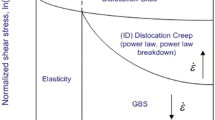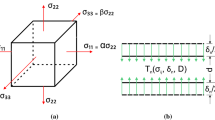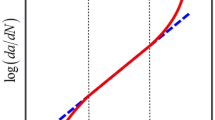Abstract
As a common practice, the compressive (negative load ratio) excursions are ignored when analyses of fatigue crack growth in metals are conducted. However, recent experimental data on fatigue crack growth with intermittent compressive load excursions have shown that the use of this assumption leads in most cases to nonconservative predictions. This paper presents a model that is capable of explaining the observed behavior, including the ‘saturation’ of the compressive overload effects, and the increase in the crack growth rate once the initial, positive load ratio profile is resumed, following a compressive excursion. The model is based on the plastic crushing of a single asperity or multiple asperities located on the crack face close to the crack tip and under dominantly plane strain conditions. A comparison of the behavior for one and for two asperities is made. Moreover, the effects of hardness and strain hardening are also examined.
Similar content being viewed by others
References
R. Bucci, ASTM STP 738 (1981) 5–28.
R.L. Carlson and G.A. Kardomateas, International Journal of Fatigue 16 (1994) 141–146.
E. Zaiken and R.O. Ritchie, Engineering Fracture Mechanics 22 (1985) 35–48.
H. Kemper, B. Weiss and R. Stickler, Engineering Fracture Mechanics 32 (1989) 591–600.
A.J. Tack and C.J. Beevers, Proceedings, Fourth International Conference on Fatigue and Fatigue Thresholds, Honolulu, 15–20 July 1990, MCPE Ltd, UK (1990) 1179–1184.
R.L. Carlson, E. Blakeley, G.A. Kardomateas and C.J. Beevers, Proceedings, Fifth International Conference on Fatigue and Fatigue Thresholds, Montreal, 3–7 May 1993, MCPE Ltd, UK (1993) 877–822.
A.J. McEvily and Z. Yang, Proceedings, Fourth International Conference on Fatigue and Fatigue Thresholds, Honolulu, 15–20 July 1990, MCPE Ltd, UK (1990) 23–36.
M.T. Yu, T.H. Topper and P. Au, Proceedings, Second International Conference on Fatigue and Fatigue Thresholds, Birmingham, 3–7 September 1984, Chameleon Press, UK (1984) 179–190.
B. Budiansky and J.W. Hutchinson, ASME Journal of Applied Mechanics 45 (1978) 267–276.
J.C. Newman, Jr., ASTM STP 748 (1981) 53–84.
O. Buck, R. Thompson and D. Rehbein, ASTM STP 982 (1988) 536–547.
P.J.E. Forsyth, International Journal of Fatigue (1983) 3–14.
L.F. Coffin, Proceedings of the Institute of Mechanical Engineers 188 (1974) 109–127.
S. Suresh, G.F. Zamiski and R.O. Ritchie, Metallurgical Transactions 12A (1981) 1435–1443.
C.J. Beevers, R.L. Carlson, K. Bell and E.A. Starke, Engineering Fracture Mechanics 19 (1984) 93–100.
R.L. Carlson and C.J. Beevers, Engineering Fracture Mechanics 20 (1984) 687–690.
W.A. Herman, R.W. Hertzberg and R. Jaccard, in Advances in Fracture Research, 7th International Conference on Fracture, vol. 2, Houston, TX, Pergamon, Oxford (1989) 1417.
R.W. Hertzberg, W.A. Herman, T. Clark and R. Jaccard, ASTM STP 1149 (1992) 197–220.
C.M. Ward-Close and C.J. Beevers, Metallurgical Transactions 12A (1980) 1435–1443.
J.R. Rice, in Fracture of Solids, vol. 2, H. Liebowitz(ed.), Academic Press, New York (1969) 218–221.
G.C. Sih, P.C. Paris and F. Erdogan, ASME Journal of Applied Mechanics (1962) 306–312.
K. Hellan, Introduction to Fracture Mechanics, McGraw-Hill, New York (1984).
G.R. Irwin, Proceedings, Seventh Sagamore Ordnance Materials Research Conference (August 1960).
F.A. McClintock and G.R. Irwin, ASTM STP 381 (1965) 84–113.
J.B. Chang, M. Szamossi and L-W. Liu, ASTM STP 748 (1981) 115–132.
J. Willenborg, R. Engle and H. Wood, Report AFFDL-TM-71-1 (1971).
S. Suresh and J.R. Brockenbrough, Acta Metallurgica 36 (1988) 1455–1470.
R.L. Carlson, G.A. Kardomateas and P.R. Bates, International Journal of Fatigue (1991) 453–460.
C.J. Beevers and R.L. Carlson, in Fatigue Crack Growth — 30 Years of Progress, R.A. Smith (ed.) Pergamon Press (1986) 89–101.
J.F. Knott, in Fatigue Crack Growth—30 Years of Progress, Pergamon, Oxford (1986) 31–52.
Author information
Authors and Affiliations
Rights and permissions
About this article
Cite this article
Kardomateas, G.A., Carlson, R.L. An inelastic multiple discrete aperities model for the effects of compressive underloads in fatigue crack growth. Int J Fract 70, 99–115 (1994). https://doi.org/10.1007/BF00034134
Received:
Accepted:
Issue Date:
DOI: https://doi.org/10.1007/BF00034134




